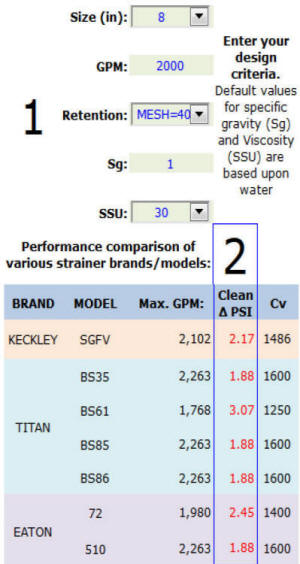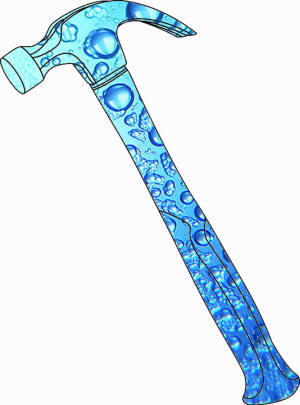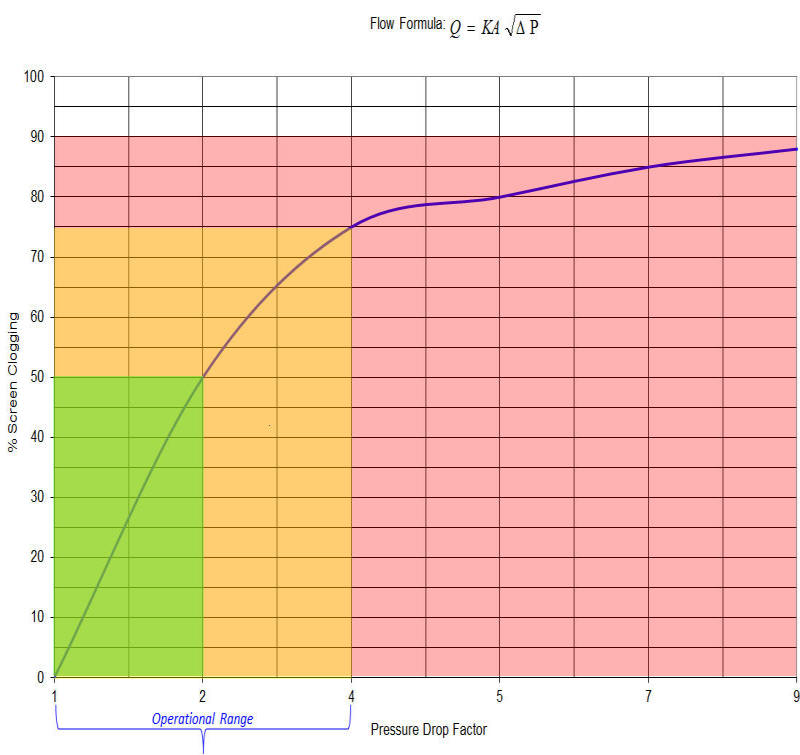When Should You Clean your Strainer Basket
Importance of differential pressure and flow coefficient
Guidelines for maintaining your filtration system depend upon factors related to your tolerance for increased differential pressure and the type of filtration system.
Clean or Replace Elements?
Generally speaking, macrofiltation applications utilize perforated or mesh lined straining elements designed to be cleaned and reused; we refer to this level of filtration as pipeline strainers. It is a common practice to use a spare element to swap-in for the clogged element and then clean that element for the next maintenance cycle. Cleaning of such elements are typically accomplished with light scrubbing and rinsing although some residual materials might require soaking in an appropriate fluid to help breakdown the clumped particulate.
Microfiltration applications usually use a disposable filter element made of a non-alloy material such as polypropylene in cylindrical cartridge or open-ended "bag" style. Do not attempt to clean fouled filter bags and cartridges. To retain particles <100 microns with efficiency requires depth filtration, trapping fine particles within the layers which make-up the filter cartridge or filter bag. Therefore, it is difficult to dislodge such entrapped particulate without disrupting the layered mesh of fibers and thereby reducing their retention efficiency.
Differential Pressure or Flow Loss Dictates Timing Filter media restricts the flow rate which is measured by the differential pressure across the inlet and outlet of your filtration system. In absence of other application specific requirements related to acceptable differential pressure across your filter equipment, the industry standard is to size the element such that the clean differential pressure is <= 5 PSIG for microfiltration systems and <= 2 PSI for macrofiltration systems.
Although strainers can have their inlet and outlet nozzles tapped to measure differential pressure, the accuracy is often improved when placing the pipeline taps the equivalent of ≥ 4 pipe diameters from the inlet and outlet nozzles. This is due to turbulence associated with the fluid changing direction and passing through the element and is associated with fluid velocity.
Even though your filter element might withstand significantly higher differential pressures, sizing for the clean differential pressure to fall within the 2-5 PSI range is a reflection of ideal fluid velocity through your filter system. High fluid velocity contributes to damage of filter elements and undermines their retention efficiency.
Centrifugal pump systems output less flow at higher pressures, so it is also applicable to associate your ideal replacement differential pressure range according to your minimum flow rate requirements.
Flow Coefficient (Cv)
The differential pressure drop across a filtration system is related to the design of the filter body AND the element. Analyze competing filter designs by comparing their Flow Coefficient value (Cv), a measure of how easily a fluid passes through the filter. Higher Cv values equate to less resistance and therefore a lower differential pressure. Beware of low cost designs having smaller bodies and elements because their Cv value will be higher. This often-overlooked aspect based upon the assumption that filters are equivalent because their connection sizes are the same, does not account for differences in the physical body and element dimensions. Lower cost designs are often made with smaller dimensions or use less material due to reduced wall thickness. When things cost less, there is usually a reason! Viscosity also affects the resistance of a liquid to flow through a filtration system. We provide online calculators enabling you to compare performance of several models simultaneously in support of making an informed decision based upon performance. Please also refer to our article "Consider the Effects of Fluid Velocity and Differential Pressure when Selecting Pipeline Strainers".

Element Design Determines Pressure Limits
Alloy strainer baskets and screens which are perforated or have a mesh lining should be cleaned or replaced once the differential pressure increases 5 PSIG above the initial clean differential pressure. Therefore, most applications will benefit from maintaining the basket/screen once the differential pressure across the system reaches 7 PSIG, even though such elements can withstand differential pressures of 25+ PSIG. The generic guideline is its time to acknowledge the element and plan for its maintenance once the system differential pressure reaches 50% of the maximum rated element differential pressure (burst pressure).
Assuming a consistent particle load, the rate of clogging, as indicated by differential pressure, is exponential because the remaining area to provide filtration (OA=Open Area) is continuously reduced while the particle load remains constant. Thus, a 50% clogged element will result in double the clean differential pressure while a 75% clogged element equates to four times the clean differential pressure. Targeting an alert to change the element once the differential pressure reaches 7 or 8 PSIG helps ensure there's adequate time to perform the required maintenance before the element completely clogs.
The alloy elements used in smaller basket strainers have burst pressures >100 PSIG whereas the larger sizes (>6") and non-alloy elements have burst pressures closer to 25 PSIG.
Disposable filer media such as cartridges and filter bags can withstand higher differential pressures, up to 35 PSI for non-alloy designs resulting in the system differential pressure target range for element replacement of 10 to 20 PSIG.
 Consider Water Hammer
Consider Water Hammer
Pressure shockwaves damage filter elements and
the potential for such pressure spikes should be considered when determining
the targeted differential pressure for element maintenance. Sudden
changes in fluid velocity, such as filling an empty pipeline quickly or a
fast-acting valve opening/closing results in a spike of pressure. This
is why it is important to consider fluid velocity during the filtration
system sizing process; systems having a low clean differential pressure
could be subject to element damage if the initial fluid velocity is too
high.
It is ideal to have a pipeline velocity 3 <= 5 FPS for non-alloy filtration systems and up to 10 FPS for alloy filtration systems involving fluids having a viscosity similar to water; higher viscosity fluids benefit from lower velocities within the 1 - 2 FPS ranges to maintain a laminar flow through the element.
Tying It All Together
Let's take a look at an example application
for a 6" pipeline strainer having a perforated basket for water filtration.
The maximum flow rate based upon the maximum clean differential pressure
guidelines is 1173 GPM; this will result in an approximate 2 PSIG
differential pressure across a clean perforated element.
However, 1173 GPM through a 6" pipeline equates to a fluid velocity of 13 FPS, which is a little too high. The maximum recommended flow rate for a 6" basket strainer falls within the 700 to 900 GPM range for an alloy strainer (8 to 10 FPS and a clean differential pressure drop of 0.7 to 1.2 PSIG) and <= 440 GPM for a non-alloy basket strainer (<= 5 FPS and clean differential pressure drop of 0.3 PSIG).
So if your flow rate is in excess of 440/900
GPM you should be considering an 8" size strainer based upon fluid velocity
and its contribution to the water hammer effect.The next time you have a
strainer application, reach out to us using one of our special web based
inquiry forms, send an email or call our office; we will put our experience
to work for you!




